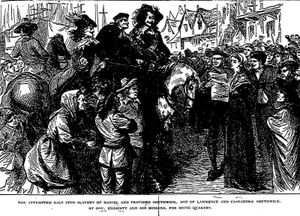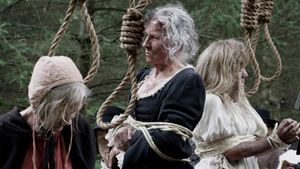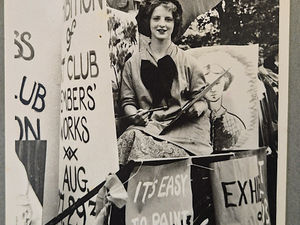The painful link between the Salem Witch Trials and West Midland Quaker families
On a night tinged crimson by burning torches, the cries of those tortured, beaten and branded devotees of the black arts pierced the stillness, writes Mike Lockley.
The desperate pleas for mercy would continue long after the pyres and torches died, their smoking last breath hanging like a pall over the sickening scene.
This is Salem in the late 1600s, a Massachusetts township that gained global infamy for the relentless persecution of residents falsely accused of witchcraft.

During a 15 month killing spree that began in February, 1692, five men and 14 women were hanged. One poor soul, Giles Corey, suffered the agonies of being “pressed” to death after refusing to enter a plea at his shambolic trial.
What happened in Salem remains a stain on America’s history.
The events have again been re-visited for current Sky drama Witches of Salem. It is among a raft of films, series, documentaries, books and articles on the grisly events.
Yet those who have written about Salem snubbed one important point – it is very much a West Midland story. A terrible West Midland story.
For no victims were more relentlessly and sadistically tormented than Lawrence and Cassandra Southwick.
They hailed from Kingswinford, then in Staffordshire and now on the edge of the Black Country, close to the current borders of both South Staffordshire and Shropshire.
They endured sustained beatings and had two of their children sold into slavery before being left to freeze to death.
Their suffering lit the fuse for the witchfinder fever that would follow.
The couple’s “heinous” crime? They followed the Quaker faith.
In the puritanical stronghold of Salem, a community founded on religious intolerance, that was enough to condemn Lawrence and Cassandra to a living hell.
They died within three days of each other on Shelter Island, a barren, frozen New York bolthole where they’d fled to escape the hate, harassment and brutality.
We have forgotten the Southwicks, but Massachusetts has not – and the state has apologised for their suffering.
A plaque on the wall of the University of Massachusetts – a plaque dedicated to a famed descendant of the couple – states: 'Royal Southwick, Lowell’s anti-slavery Quaker senator and manufacturer and a descendant of Lawrence and Cassandra Southwick who were despoiled, imprisoned, starved, whipped, banished from Massachusetts Bay Colony and persecuted to death in the year 1660 for being Quakers.'
Details of Lawrence and Cassandra’s Black Country days are sketchy. Census records reveal they were married in Kingswinford on January 25, 1623, and travelled to Salem in search of a new life between 1637 and 1639.
Ironically, the couple chose to leave England because of the religious intolerance they had encountered here. They were doomed to step out of the frying pan and into the fire.
Lawrence took the skills learnt at home with him: he is referred to as one of America’s pioneer glass-blowers.

Hounding by Salem locals, forced him to quit the successful business and follow a career in animal husbandry. He excelled at that, too.
Looking back, Lawrence and Cassandra arrived in the township at the wrong time, with a growing band of radical Puritans already pushing their blinkered agenda. Their way, they bellowed, was the one and only path to redemption.
The man and wife were among a group of settlers who referred to themselves as the Society Friends, later to be known as Quakers because they “trembled in the way of The Lord”.
Despite the threats and violence, they bravely refused to compromise their beliefs, would not pay tithes to the state church, snubbed oaths of allegiance and, most telling of all, steadfastly refused to stand-up for Salem in combat.
To an extent, they were as belligerent as their oppressors.
Confrontation was inevitable. The fanatical Puritans were prepared to do whatever it took to save the newcomers’ souls – even murder.
If death was necessary to save someone from eternal damnation, then so be it.
They were also prepared to stem the trickle of pioneers, to make Salem a 'no go area' for Quakers.
In 1656, two Quakers were discovered on a recently docked ship and immediately inspected for 'witch marks'. The Satanic war had begun.
When no signs of the devil could be found on their bodies, the pair were immediately deported and a law introduced banning ship captains from bringing Quakers to Massachusetts.
Yet still the Quakers came, driven by a missionary zeal.
They were beaten by rabid mobs, flogged and dragged over the state border only to return when their wounds had healed.
In an attempt to end the influx, tough, cruel laws were introduced, giving Puritans the power to cut off the ears of returning Quakers, burn holes through their tongues and brand them with hot irons.
Capital punishment inevitably followed, with the first four Quaker executions taking place on Boston Common.
The Southwicks were living on borrowed time in a troubled time.
In 1657, they were heavily fined and flung in prison for allowing two Quaker preachers to stay at their home. Records show Cassandra spent seven weeks behind bars and was fined 40 shillings.
The couple refused to submit or surrender their faith.
One year later, Lawrence, Cassandra and their son, Joshua, were imprisoned for 20 weeks after refusing to attend a Puritan church service. Unable to pay the substantial fine that went with the punishment, the family were stripped of their possessions.
Bigotry had made them homeless and penniless.
In 1659, daughter Provided and son Daniel were wrenched from the Southwicks, taken to Barbados and sold as slaves to meet outstanding court costs.
Interestingly, local ship crews and captains refused to play any part in forcibly taking the children to the Caribbean which suggests a fair percentage of Salem folk supported the Southwicks and were opposed to the campaign against the family.
In the end, even Lawrence and Cassandra, fearing for their lives, buckled. They took what little they had and travelled to Shelter Island, a muddy, barren patchwork of fields owned by the Slyvester family who had turned the acres into a sanctuary for Quakers.
The couple were already broken when they arrived at Shelter Island. They lacked the strength to work the poor soil.
One surviving record chillingly reveals their fate: “Lawrence and wife Cassandra went to Shelter Island, Long Island Sound, being banished under pain of death in 1659 and died there in the spring of 1660 from privation and exposure; his wife died three days after him.”
Their deaths pricked Salem’s conscience and helped residents to see the Puritan purges for what they were.
The town demanded change and in 1661 King Charles II – the colony was then under British rule – issued a royal order to end the persecution of Quakers.
Despite attempts to wipe clean the memory of Lawrence and Cassandra from Salem and from history itself, the couple made a lasting mark.
The religious fanatics failed miserably, for the couple’s thousands of descendants included Winston Churchill and US president Richard Nixon.
Best-selling author Stephen King wrote of 'Salem’s Lot'. The world needs to remember Salem’s Lot was the lot of a poor West Midland family.
THE end of Quaker persecution in Salem did not spell the end of slaughter in God’s name.
In the 1690s, elders turned their attention towards so-called devil worshippers.
It is now believed the bloody rampage had its roots in mass hysteria.
In 1692, Betty Parris, the nine-year-old daughter of Rev. Samuel Parris, and her cousin Abigail Williams, aged 11, began to suffer fits.
The girls made strange sounds while their bodies convulsed and rumours they were possessed spread like wildfire.
An emergency meeting at Salem Village Hall called over the phenomenon was interrupted when a number of children in attendance were gripped by the same symptoms. Their response was psychosomatic, scientist now believe, triggered by public debate over the girls’ ailment.
The accusations levelled at the first three woman arrested reveals the level of intolerance that existed.
“Tituba”, a slave of native South American origin, was accused of telling “stories of enchantment”.
Sarah Good, a homeless down-and-out, had failed to show “self control”. Sarah Osbourne was slapped in chains for being absent at church services.





